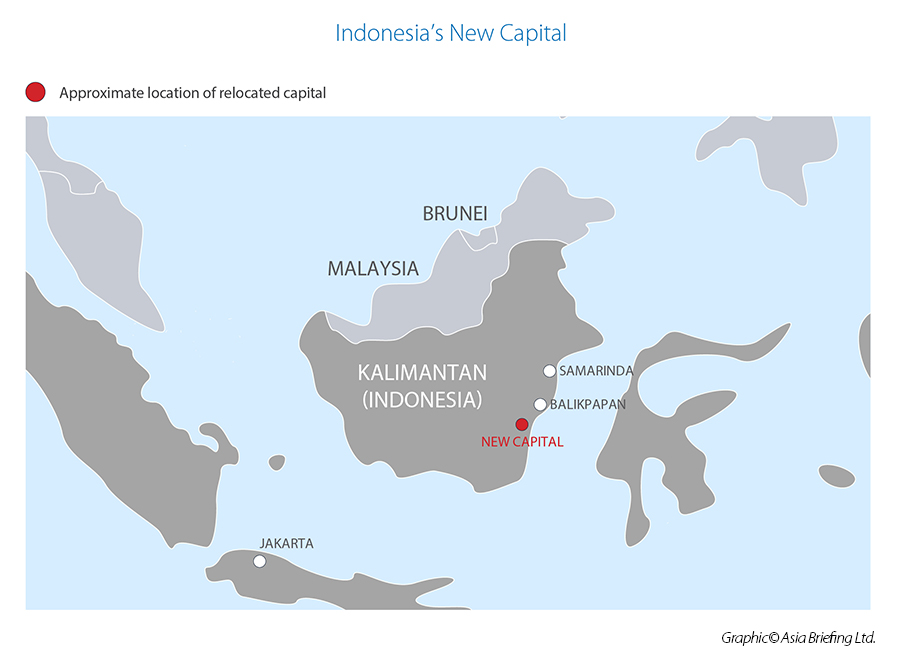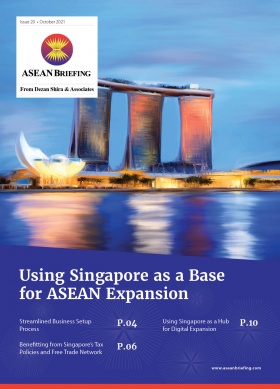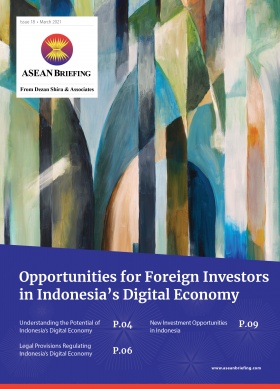Indonesia Passes Bill to Build New Capital City: Deadline 2024
Indonesia is working to build a new capital from scratch—Nusantara. We discuss the Joko Widodo government’s motivations and key objectives of the planning process as well as some of the external stakeholders involved.
On January 18, 2022, Indonesia’s Parliament passed the Capital City Bill into law meaning the construction of the country’s new capital can begin, ahead of the planned relocation from Jakarta starting in early 2024 to East Kalimantan province.
Indonesia’s new capital, which was first announced in 2019, is estimated to cost over US$35 billion to construct. The government has also just announced the name ‘Nusantara’ meaning archipelago – to be the new capital’s name. It is meant to underline Indonesia’s official national motto of Bhinneka Tunggal Ika (Unity in Diversity).
The government will transform the new capital into a low-carbon superhub that will support healthcare and technology sectors as well as promote sustainable growth beyond the island of Java.But the new capital needs major investment for its development and this presents ample opportunities for foreign businesses. From the US$35 billion required for construction, the government will fund just under 60 percent, with the remainder to come from the private sector. Indonesia is now finalizing a regulation that offers an array of fiscal and non-fiscal incentives to attract foreign investors into Nusantara.
President Joko Widodo has assembled a team of political and business heavyweights as part of the new capital’s steering committee. These include Abu Dhabi Crown Prince Muhammad bin Zayed Al Nahyan and former British Prime Minister Tony Blair.
Why is Indonesia moving its capital?
The plan to move Indonesia’s capital has been suggested by Indonesia’s first President, Sukarno in 1957. He wanted a purpose-built capital located in the country’s geographic center in the city of Palankaraya in Central Kalimantan province. This plan was abandoned, and Jakarta was declared the country’s capital during the 1960s.
Indonesia’s sixth President, Susilo Bambang Yudhoyono also floated the idea to create a new political and administrative center due to Jakarta’s overpopulation problems.
Spreading wealth across Indonesia
This latest push for the new capital by President Joko Widodo came shortly after he won his second five-year term in office in 2019. Widodo stated that the relocation of the new capital was to address economic inequality in Indonesia and to relieve the burden on Jakarta and the island of Java where it is located.
According to a 2020 census, Java has a population of 152 million or 56 percent of Indonesia’s total population of 271 million. This demographic advantage over the other islands means some 60 percent of Indonesia’s GDP is concentrated on Java, with Jakarta contributing to one-fifth of Indonesia’s GDP. Meanwhile, the five provinces of Kalimantan (West, Central, East, North, and South) contribute less than 10 percent to the total GDP and have less than seven percent of the population. This is despite the provinces having an abundance of commodities from coal to gold to oil.
East Kalimantan, however, does have the country’s second-highest gross regional domestic product (GRDP) per capita at 125 million rupiah (US$8,700), behind Jakarta.
Relocating the capital to East Kalimantan, the government hopes will encourage greater investments to Indonesia’s outer lying provinces, especially those towards the east of the country.
A sinking Jakarta
Rapid urbanization in Jakarta, being the center of government, business, finance, and trade and services, has resulted in it becoming the most populous urban agglomeration in the world, with a population of some 30 million.
Jakarta has long suffered from investments in hard infrastructure, and as a result, the city is known for its notorious congestion and flooding. Jakarta loses over US$6 billion annually in lost productivity due to congestion and over US$500 million due to flooding. The city does not pipe-in drinkable water so residents extract groundwater, resulting in its over-extraction and the land slowly collapsing.
Parts of Jakarta are sinking at an estimated 25cm per year and around 25 percent of the capital could be submerged by 2050. This could be more widespread with the impact of climate change.
What opportunities are there for foreign investors?
The new capital, Nusantara, will sit on a 632,850-acre site, roughly four times larger than Jakarta, and as such, this ambitious project presents opportunities for investors from a wide range of industries.
Nusantara will require soft and hard infrastructure, such as for the development of urban utilities, toll manufacturing, seaports and airports, and network and communications, among others. This will be achieved gradually, starting from the presidential palace, the central government headquarters, housing districts for government workers, and the headquarters for the military and police personnel.
Smart city development
Nusantara aims to be a ‘smart city’, which encompasses information, communication, and technology to improve operational efficiencies and provide a better quality of government services.
The government plans to utilize the internet of things (IoT) to deliver connected solutions to the public from monitoring traffic flows to energy conservation. Some 75 percent of the planned site of the capital city will be green open space, of which 65 percent is protected area and 10 percent is for food production.
Maritime infrastructure
When he first entered office in 2014, Widodo announced plans to turn Indonesia into the epicenter of Indo-Pacific maritime activity through the Global Maritime Fulcrum (GMF) master plan.
The plan involved investing more than US$6 billion to expand ports in the world’s largest archipelago and reduce logistic costs for investors. The government also hopes this would encourage the establishment of industrial production outside of Java, particularly in the eastern regions of the country where large industrial activity remains low. And yet, Indonesia’s eastern regions cover 64 percent of the country.
The flagship sea toll program
The sea toll program is the government’s flagship project under the GMF with the aim of reducing the price disparity of basic goods between the main islands in Indonesia and the smaller isolated islands, especially those in the east.
Since its inception in 2016, the number of transit ports has increased from 31 to 114 in 2021 and the number of vessels from six to 32. Sea cargo has also increased from less than 100,000 tons to more than 350,000 tons.
Under Indonesia’s positive investment list, airports and seaports are now open to 100 percent foreign ownership, from the previous 49 percent. In addition, airport-related services and seaport facilities are also now open to 100 percent foreign ownership.
Renewable energy
Indonesia needs enormous private capital to achieve its renewable energy mix of 25 percent by 2025; it currently stands at 14.7 percent.
With the new capital being built from scratch, there is plenty of potentials to develop new renewable projects. This is despite the provinces of Kalimantan being renowned for their coal, gold, oil, timber, and palm oil exports.
East Kalimantan province does possess huge potential for clean energy with research from the Ministry of Energy and Mineral Resources showing that the combined sources of wind power, biofuels, solar power, hydropower, and other renewable energy sources can reach 20 GW. Solar power comprises 65 percent of this total while hydroelectric power, 26 percent. Another potential renewable energy source in the province is in the form of geothermal energy.
Further Reading
- Indonesia’s Omnibus Law: New Protection and Empowerment Measures for Small Businesses
- Qualifying as a Reputable Exporter and Importer in Indonesia
- Indonesia’s Omnibus Law: New Provisions for the Shipping Sector
About Us
ASEAN Briefing is produced by Dezan Shira & Associates. The firm assists foreign investors throughout Asia and maintains offices throughout ASEAN, including in Singapore, Hanoi, Ho Chi Minh City, and Da Nang in Vietnam, Munich, and Esen in Germany, Boston, and Salt Lake City in the United States, Milan, Conegliano, and Udine in Italy, in addition to Jakarta, and Batam in Indonesia. We also have partner firms in Malaysia, Bangladesh, the Philippines, and Thailand as well as our practices in China and India. Please contact us at asia@dezshira.com or visit our website at www.dezshira.com.









